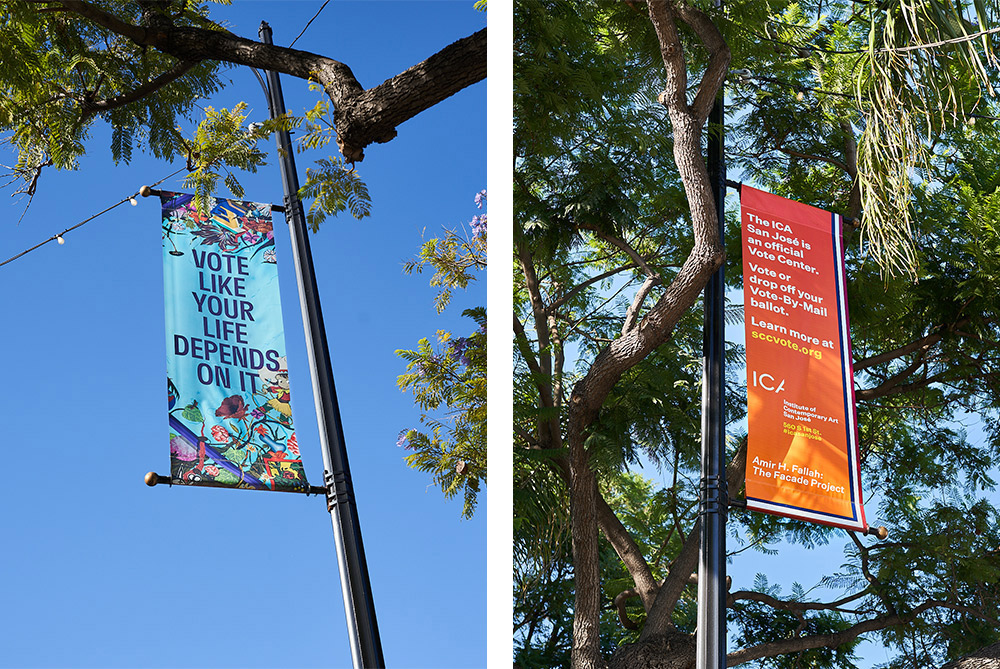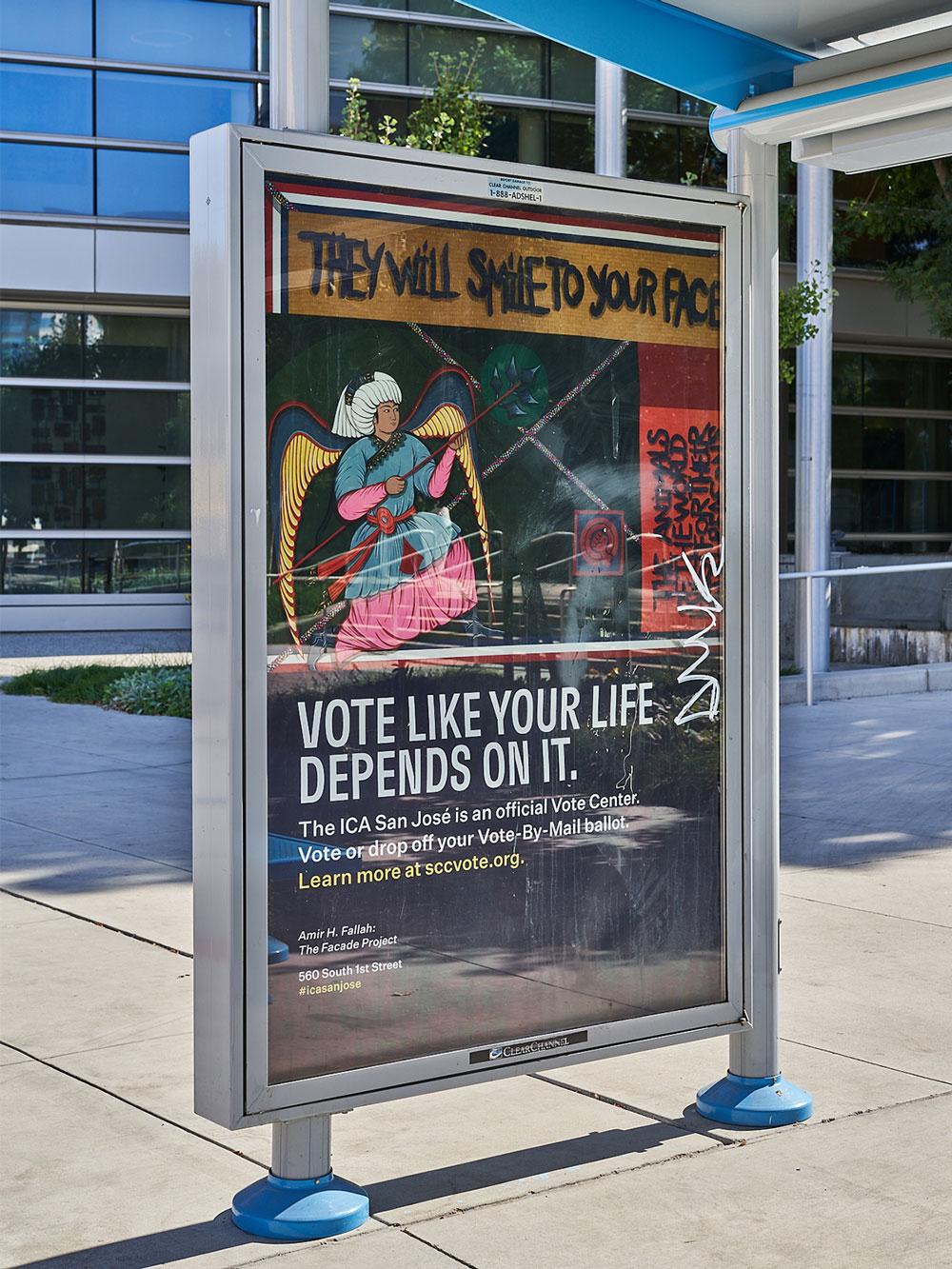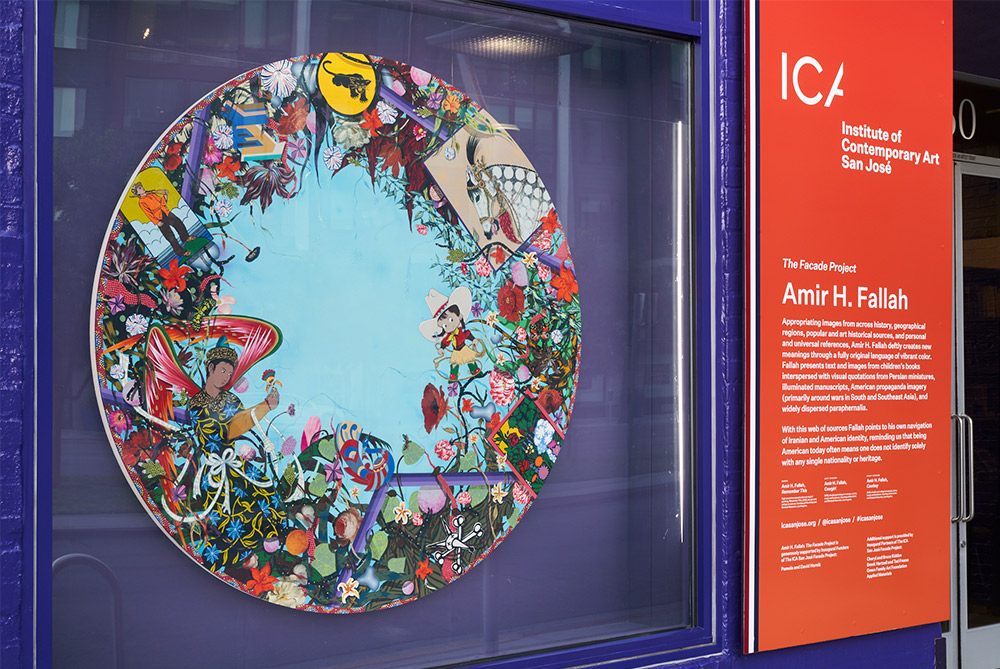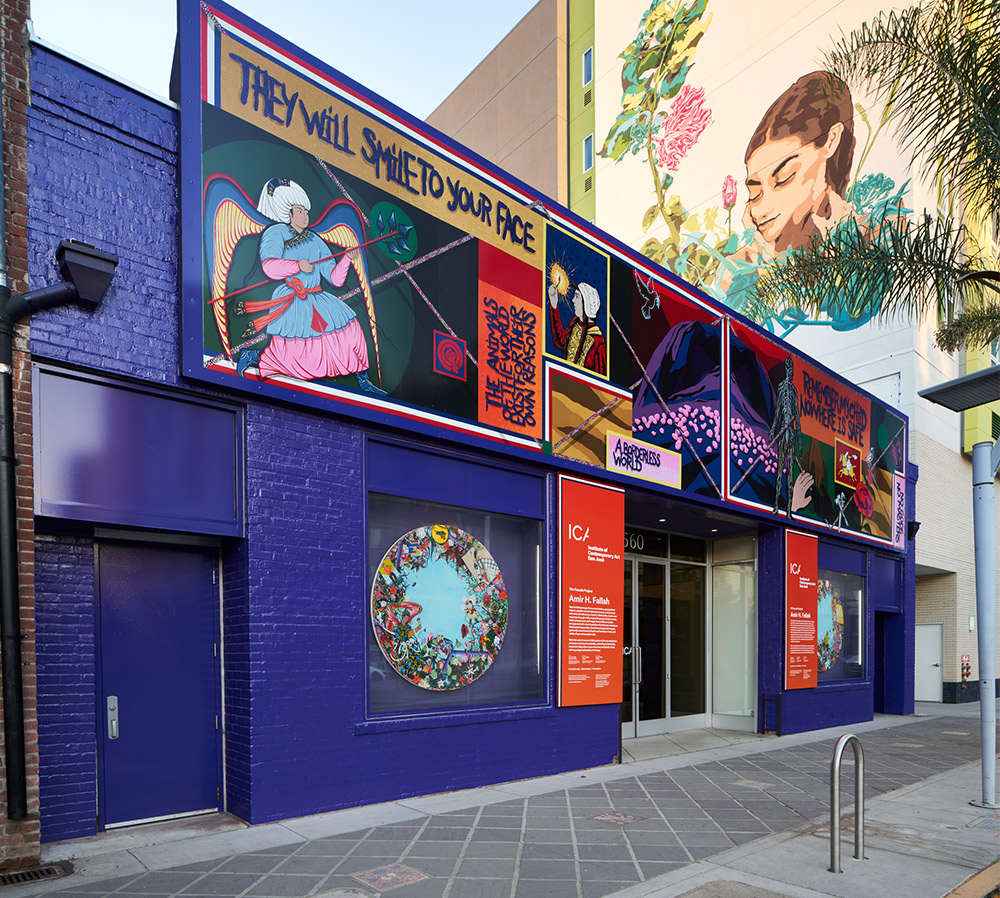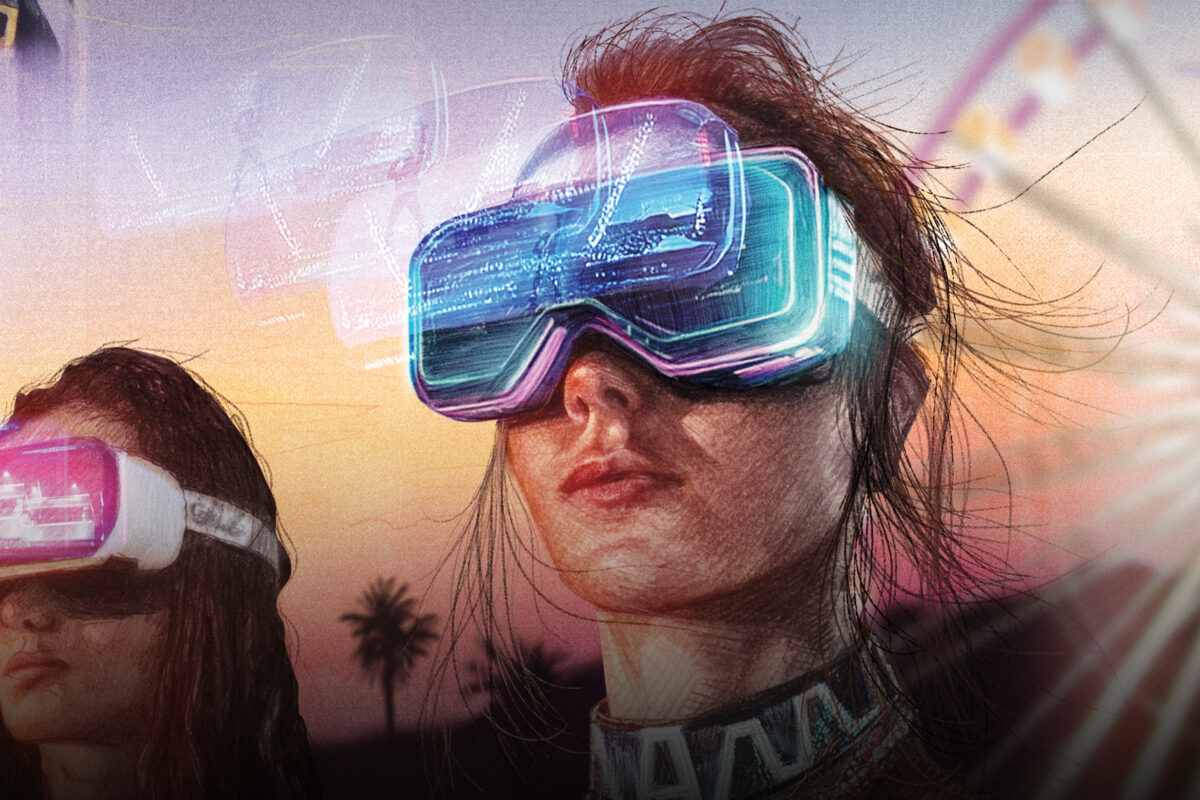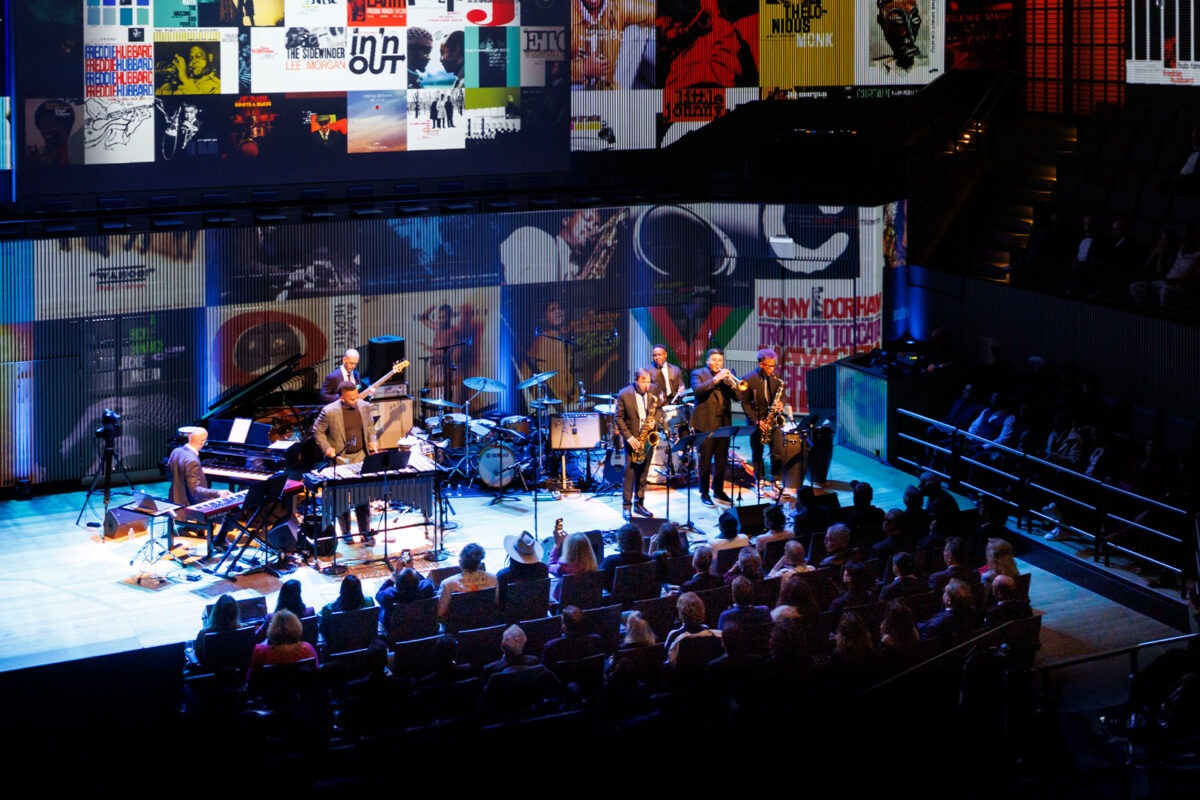The Institute of Contemporary Art San José reopens for voting with a site-specific facade created by L.A.-based Amir H. Fallah
Words by ELIZABETH VARNELL
Now that voting centers are California’s new polling places, all of us can make our mark at a center of our choice in our respective county rather than being limited to an assigned spot. So why not fill out a ballot — or drop off the completed version — at one that’s eye-catching? That’s precisely the question Los Angeles-based artist Amir H. Fallah is asking. His new work The Façade Project, a takeover of the Institute of Contemporary Art San José’s exterior that includes a 50-foot vinyl mural and two 6-foot circular rotating paintings, depicts his personal take on American identity and the complexity of navigating a place whose citizens often identify with multiple nationalities.
“I’ve always dealt with this feeling of not belonging 100 percent, and this work is about having empathy, even if you don’t understand someone’s plight,” says Fallah, 41, who was born in Iran and had lived in Italy, Turkey and the United States by the age of 6. Working over two months, Fallah mixed high and low cultural signifiers and East and West symbols, rifling through children’s books for texts and illustrations. The phrases “Remember my child nowhere is safe,” and “They will smile to your face” are emblazoned across the museum’s exterior.
The space, currently closed due to California’s pandemic restrictions, is slated to open to the public in December, but those arriving for in-person voting (both early and on election day), ballot drop-off, replacement ballot requests, a host of other election-related services — or just walking down the street — will get a first-hand look at Fallah’s facade. “The mural is just basic acrylic paint on canvas, reproduced in vinyl,” Fallah says. “We photographed it so you can see the texture on the canvas, you can see every brush mark.”
The site-specific work began to take shape over this past summer when the ICA’s new executive director, Alison Gass, who is also its chief curator, sought to commission a project to “navigate the critical issues the world should be talking about.” Due to the pandemic, an exterior painting seemed safest and Gass proposed the idea to Fallah because she says she envisioned something “colorful and visually delicious to look at.” The 2020 Artadia award winner’s practice includes vibrant portraits that depict personal history and identity through objects, belongings and clothes rather than typical descriptors — such as faces — that are often obscured.
The ICA’s transformation into a voting center is part of an effort throughout the state to reimagine polling places. Other arts organizations also hosting voting centers include San Francisco’s Bill Graham Civic Auditorium, San Jose’s Hammer Theatre Center, and Los Angeles’ Hammer Museum, Dorothy Chandler Pavilion, Debbie Allen Dance Academy, Pantages Theatre, Hollywood Palladium, Hollywood Bowl, Magic Castle, The Wiltern, Banc of California Stadium, and Staples Center. This election, there are certainly a plethora of art-adjacent offerings, and plenty to ponder both inside — and outside — the booth for anyone choosing to vote in person in the coming days. Here, we speak with Fallah about the works he created for the ICA facade and his vision for voters.
“Why not make it a great experience to go vote? I feel like that about everything in life. Why not have beauty?”
AMIR H. FALLAH
How did you approach the concept of creating art to adorn a vote center?
Why can’t it be beautiful? People die for the right to vote, why can’t it be a beautiful experience? Why would you make obstacles to make it difficult to vote? Why does it have to be a local gymnasium? I like the idea of “why aren’t museums voting centers” or “a botanical garden”? Why not make it a great experience to go vote? But I feel like that about everything in life. Why not have beauty? Why not try to be surrounded by beauty?
How do you imagine this project will be perceived?
I like the idea of someone walking past, not knowing it’s a museum. Stopping in their tracks, pondering the text and how it relates to the images. Or just slowing their pace. Things are so chaotic and confusing in California. With fires, COVID, political meltdowns, it’s hard to focus on one disaster at a time.
How does the text relate to the images?
My fall show in L.A. [at Shulamit Nazarian] had me thinking of my 5-year-old son, and the stories I read to him. Children’s books are a way parents pass on beliefs and life lessons to kids. It’s a dialogue of texts and images. Sometimes images are colliding with text or adding to the text. Each painting is a life lesson to pass to my son.
What has it been like to create these pieces during the pandemic?
Work got a whole new meaning and new life after March 12. The paintings deal with environmental issues, but COVID highlighted that we’re in a crisis. The way we treat animals is how we treat other people, how we treat the world. It’s all interconnected.
The two tondos on view in the windows at the ICA explore this idea.
They’re circular with collages and other elements, rotating slowly into each other. Tumbling, collapsing colliding, highlighting the moment. There’s no top and bottom, everything’s in constant motion.
The complexity of identity is a major theme in these works. How does that relate to the vine-like flora and fauna imagery?
The works are part of a series called Atlas with botanical imagery from all over the world from African orchids to succulents in California. People migrated, but plants did too. People brought plants as medicine and food too as they traveled. A vegetable that grew in Asia, suddenly it’s in California. It’s all related to the migration of people.
Plants are colliding, clashing, growing together, wrapping around each other.
Chaos or harmony. It’s a metaphor for the U.S., different cultures and viewpoints always in a constant state of flux. Never still and pretty like a Dutch still life.
What else is in the tondos?
Snippets of everything from advertisements, a bootleg Frank Stella painting to show macho 1960s American minimalist abstraction, and wartime propaganda images next to Persian miniatures. Also cartoonish vintage Valentine’s Day card images of a cowboy and cowgirl, happy and smiling. Isn’t the cowboy the ultimate symbol of Americana?
The Façade Project began as a billboard to be placed above the museum.
I’m a maximalist in every sense of the word when it comes to my artwork. I thought it really would be cool to cover the entire building. Ali made it happen.
Early voting Oct. 31-Nov. 2, 9 a.m. to 5 p.m., election day voting Nov. 3, 7 a.m.-8 p.m. Institute of Contemporary Art San José, 560 S. First St., San José.
Feature image and all photos: “The Facade Project” by AMIR H. FALLAH adorns THE INSTITUTE OF CONTEMPORARY ART SAN JOSÉ.
Oct. 30, 2020
Discover more CULTURE news.


